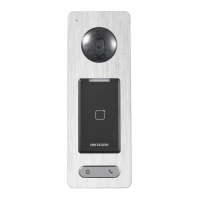Video Access Control Terminal User Manual
81
3. Click OK to confirm assigning the card(s) to the selected card type.
4. For the Visitor Card, you can click the added card and click Edit to edit the Max. Swipe Times, card Effective
Time and Expiry Time.
Note: The Max. Swipe Times should be between 0 and 255. When setting as 0, it means the card swiping is
unlimited.
5. Click Apply Settings button to take effect of the new settings.
6. (Optional) You can click Delete to remove the card from the card type and the card can be available for
being re-assigned.
Card Reader Authentication
You can set the passing rules for the card reader.
Steps:
1. Click Card Reader Authentication tab and select a card reader on the left.
2. Select a card reader authentication mode. The available authentication modes depend on the card reader
type:
Card and Password: The door can open by both inputting the card password and swiping the card.
Note: Here the password refers to the password set when issuing the card. Refer to 4.2.1 Empty Card.
Card or Authentication Password: The door can open by inputting the authentication password or
swiping the card.
Note: Here the authentication password refers to the password set to open the door. Refer to
4.7.8 Multi-door Interlocking
You can set the multi-door interlocking between multiple doors of the same access control device. To open one
of the doors, other doors must keep closed. That means in the interlocking combined door group, up to one door
can be opened at the same time.
Notes:
The Multi-door Interlocking function is only supported by the access control device which has more than
one access control points (doors).
Either the anti-passing back or multi-door interlocking function can be configured for an access control
device at the same time.
Steps:
1. Click Multi-door Interlocking tab and select an access control point from the list.
2. Click Add to pop up the Add Access Control Point to Interlock interface.

